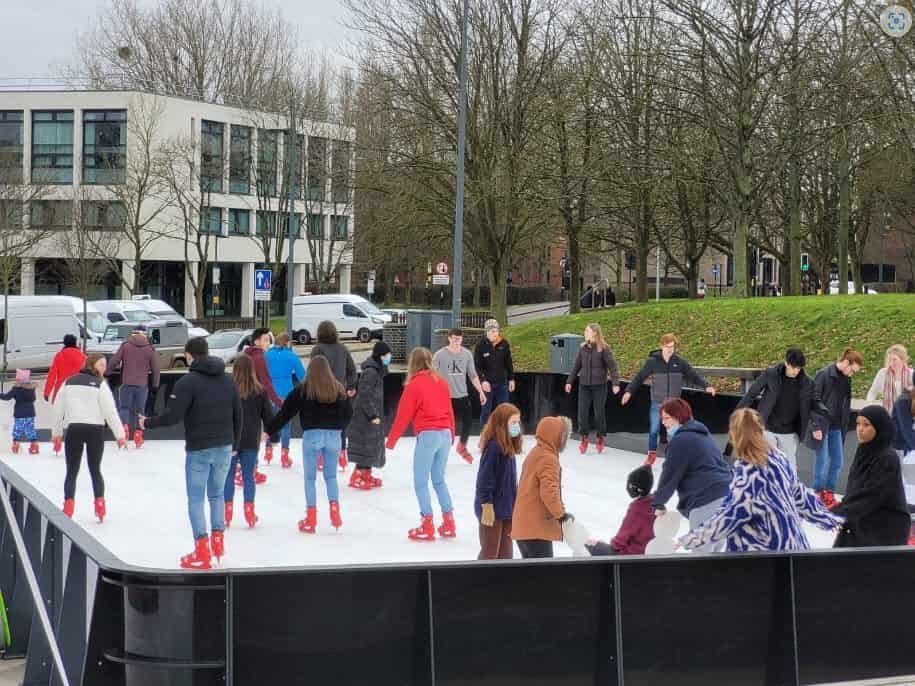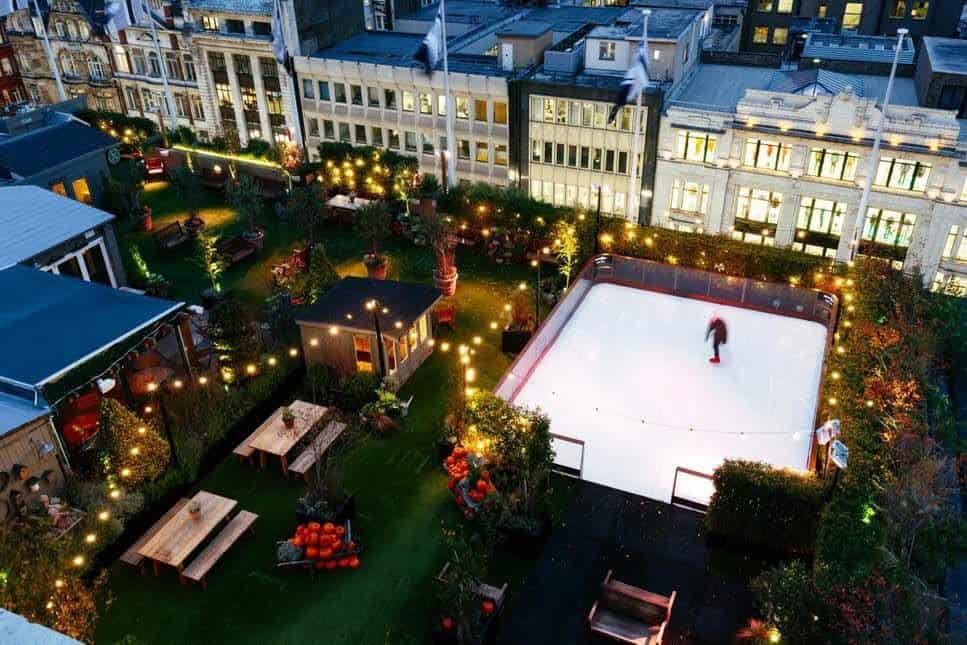A synthetic ice rink surface is made from a type of plastic known as high-density polyethylene (HDPE) or ultra-high molecular weight polyethylene (UHMW-PE). These materials are chosen for their durability, low-friction properties, and ability to mimic the glide and feel of natural ice.
Composition and Characteristics
- High-Density Polyethylene (HDPE): HDPE is a type of thermoplastic polymer known for its strength, density, and resistance to impact. It is less expensive than UHMW-PE, making it a popular choice for budget-friendly installations. However, it offers slightly less glide efficiency compared to UHMW-PE.
- Ultra-High Molecular Weight Polyethylene (UHMW-PE): UHMW-PE is a subset of the thermoplastic polyethylene. It has longer chains and a higher molecular weight than standard polyethylene, which gives it superior durability, lower friction, and a smoother glide. It is often preferred for higher-end synthetic ice rinks due to its closer resemblance to real ice in terms of skating experience.
Manufacturing Process
- Sinter-Pressed or Extruded Sheets: Synthetic ice panels are typically manufactured through a sinter-pressing or extrusion process. These processes result in large, flat panels that can be interlocked to create the rink surface.
Surface Properties
- Glide Factor: One of the key challenges in creating synthetic ice is achieving a glide factor that closely mimics real ice. Additives are often mixed with the polyethylene to reduce friction, allowing for a smoother glide. These can include silicone and other lubricants.
- Self-Lubricating Technology: Some modern synthetic ice rinks utilize self-lubricating materials that release lubricants over time. This technology reduces the need for external glide enhancers and maintenance.IntroductionArtificial ice rinks have revolutionized the world of ice sports and recreation, offering a versatile platform that caters to a wide range of activities and interests. From the fast-paced intensity of ice hockey to the elegance and grace of figure skating, these rinks provide a canvas for athletes and enthusiasts to express themselves and pursue their passion. In this article, we will explore the incredible versatility of artificial ice rinks, showcasing how they accommodate both hockey and figure skating, and the unique opportunities they offer to individuals and communities.1. Hockey: The Heart-Pounding Sport on Artificial Ice Rinksa. The Evolution of Ice HockeyIce hockey, with its roots in the frozen ponds of Canada, has become a global phenomenon. The game has evolved significantly since its inception, with rules, equipment, and strategies continually developing. Today, ice hockey is not just a sport; it’s a way of life for millions of enthusiasts worldwide.
b. Artificial Ice Rinks and Hockey
Artificial ice rinks have played an integral role in the growth of ice hockey. These rinks offer consistent ice conditions, allowing players to focus on their skills and teamwork. They facilitate year-round training and competition, eliminating the need to wait for natural ice to freeze.
c. A Hub for Development
Artificial ice rinks serve as breeding grounds for aspiring hockey players. They provide access to coaching, organized leagues, and tournaments that nurture talent from a young age. These rinks are essential for the development of the next generation of hockey stars.
d. Inclusivity and Diversity
Hockey is a sport for everyone, regardless of age, gender, or skill level. Artificial ice rinks make the sport accessible to individuals who may not have grown up in traditional hockey regions. They encourage diversity and inclusivity within the hockey community.
e. Opportunities for Competitive Play
Artificial ice rinks are host to a wide range of hockey events, from youth and amateur leagues to professional and international competitions. These rinks have witnessed legendary moments and intense rivalries, showcasing the passion and spirit of the sport.
2. Figure Skating: The Artistry and Elegance on Artificial Ice Rinks
a. A Dance on Ice
Figure skating is a graceful and artistic discipline that combines athleticism with elegance. Skaters perform intricate routines that require precision, creativity, and poise. It’s a sport that captivates audiences with its beauty and storytelling.
b. Artificial Ice Rinks and Figure Skating
Artificial ice rinks serve as the canvas for figure skaters to express themselves. They offer a controlled environment where skaters can practice their jumps, spins, and choreography. The consistent ice quality is crucial for executing intricate moves.
c. The Role of Coaches
Coaches play a vital role in the world of figure skating, guiding skaters in their pursuit of excellence. Artificial ice rinks provide a space where coaches can mentor their students and help them refine their techniques and routines.
d. Showcasing Talent
Artificial ice rinks host a variety of figure skating events, including local competitions, regional championships, and international showcases. These events give skaters the opportunity to showcase their talent, connect with fellow enthusiasts, and inspire the next generation of figure skaters.
e. Artistry and Interpretation
Figure skating goes beyond technical skills; it’s about interpreting music and telling a story on the ice. Skaters use their routines to convey emotions and connect with the audience, creating a unique and unforgettable experience.


3. The Unique Overlap: Synchronized Skating
a. A Blend of Teamwork and Precision
Synchronized skating is a unique discipline that combines elements of both hockey and figure skating. It involves teams of skaters performing choreographed routines in perfect harmony. This captivating sport highlights the versatility of artificial ice rinks.
b. Artificial Ice Rinks as a Stage
Synchronized skating teams practice and compete on artificial ice rinks, showcasing their intricate formations, intricate footwork, and synchronized movements. These rinks provide the ideal platform for teams to fine-tune their routines.
c. National and International Competitions
Synchronized skating has gained popularity and recognition on a global scale. Artificial ice rinks host national and international competitions that attract teams from various countries, fostering camaraderie and healthy competition.
4. The Social and Community Aspect
a. A Gathering Place
Artificial ice rinks often serve as community hubs. They bring people together, whether for a friendly game of pickup hockey, public skating sessions, or figure skating classes. These rinks foster a sense of belonging and shared passion.
b. Cultural Exchange
Ice sports have the power to transcend borders and cultures. They facilitate cultural exchange and friendship among athletes and enthusiasts from different backgrounds. Artificial ice rinks are venues where this exchange takes place, fostering global connections.
c. Supportive Communities
The hockey and figure skating communities are known for their support and camaraderie. Skaters and players alike find encouragement and friendship within these communities, enriching their lives both on and off the ice.
5. Accessibility and Sustainability
a. Year-Round Availability
Artificial ice rinks offer year-round access to ice sports, eliminating the limitations imposed by changing seasons and weather conditions. This accessibility is especially valuable for individuals and communities in regions with mild or warm climates.
b. Environmental Considerations
In recent years, there has been increased attention to the environmental impact of artificial ice rinks. Efforts are being made to improve the sustainability of these facilities by using energy-efficient refrigeration systems and exploring alternative refrigerants with lower global warming potential.
Conclusion
Artificial ice rinks are not just frozen surfaces; they are dynamic arenas that cater to the diverse interests and talents of the skating community. From the intensity of ice hockey to the artistry of figure skating, these rinks provide a space where athletes and enthusiasts can pursue their passions, compete, and come together as a community. The versatility and accessibility of artificial ice rinks make them invaluable assets to individuals, families, and communities, bridging the gap between sports and artistry on the frozen canvas. As these rinks continue to evolve, they will undoubtedly inspire future generations of skaters, fostering a love for ice sports that transcends boundaries and endures for years to come.


